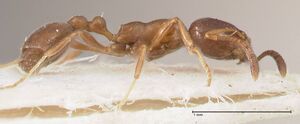Cardiocondyla unicalis
| Cardiocondyla unicalis | |
|---|---|

| |
| Scientific classification | |
| Kingdom: | Animalia |
| Phylum: | Arthropoda |
| Class: | Insecta |
| Order: | Hymenoptera |
| Family: | Formicidae |
| Subfamily: | Myrmicinae |
| Tribe: | Crematogastrini |
| Genus: | Cardiocondyla |
| Species: | C. unicalis |
| Binomial name | |
| Cardiocondyla unicalis Seifert, 2003 | |
Known only from the holotype worker, nothing is known about the biology of Cardiocondyla unicalis.
Identification
Seifert (2003) - A member of the Cardiocondyla shuckardi group. The unique combination of rare characters justifies the description of C. unicalis, based upon a single specimen. These characters are extremely small eyes, very narrow postpetiole, very short head, large size, the long scape, slender mesosoma with a deep metanotal impression, and reduced spines. The next similar species is Cardiocondyla fajumensis, from which it differs by the extremely small CL/CW, being fully outside the expected range of variation in C. fajumensis. Further differences to C. fajumensis are the weaker sculpture, the smaller eyes, the shorter scape, and the darker colour.
Keys including this Species
Distribution
Latitudinal Distribution Pattern
Latitudinal Range: 33.33333333° to 33.33333333°.
| North Temperate |
North Subtropical |
Tropical | South Subtropical |
South Temperate |
- Source: AntMaps
Distribution based on Regional Taxon Lists
Palaearctic Region: Iran (type locality).
Distribution based on AntMaps
Distribution based on AntWeb specimens
Check data from AntWeb
Countries Occupied
| Number of countries occupied by this species based on AntWiki Regional Taxon Lists. In general, fewer countries occupied indicates a narrower range, while more countries indicates a more widespread species. |

|
Estimated Abundance
| Relative abundance based on number of AntMaps records per species (this species within the purple bar). Fewer records (to the left) indicates a less abundant/encountered species while more records (to the right) indicates more abundant/encountered species. |

|
Biology
Castes

| |
| . | |
Nomenclature
The following information is derived from Barry Bolton's Online Catalogue of the Ants of the World.
- unicalis. Cardiocondyla unicalis Seifert, 2003a: 262, fig. 42 (w.) IRAN.
- Type-material: holotype worker.
- Type-locality: Iran: Loristan, Ma’amulan, 33°20’N, 47°54’E, 6.viii.1973 (A. Senglet).
- Type-depository: SMNG.
- Status as species: Paknia, et al. 2008: 153; Borowiec, L. 2014: 49.
- Distribution: Iran.
Unless otherwise noted the text for the remainder of this section is reported from the publication that includes the original description.
Description
Worker
holotype: CS 610, CL/CW l.126, SL/CS 0.837, PoOc/CL 0.451, EYE 0.199, dFOV 19.0, FRS/CS 0.270, SPBA/CS 0.250, SP/CS 0.051, PEW/CS 0.272, PPW/CS 0.411, PEH/CS 0.290, PPH/CS 0.278, PEW/PPW 0.661, sqrtPDG 4.01, PLG/CS 4.75 %, MGr/CS 4.92 %.
Large, CS 610. Head extremely short, CL/CW 1.126. Postocular distance large, PoOc/CL 0.45l. Scape long, SL/CS 0.837. Eyes extremely small (EYE 0.199), with very few microsetae of 4 - 6 mm length. Occipital margin straight. Sculpture on head, mesosoma and waist much weaker than in Cardiocondyla fajumensis. Foveolae on paramedian area of vertex shallow, but rather large (dFov 19 mm), frequently bicoronate, with irregular margins; interspaces between foveolae usually present but much narrower than foveolar diameter. Median and paramedian areas of vertex and frontal laminae longitudinally carinulate. Clypeus with few weak longitudinal rugae. Frontal carinae immediately behind FRS level slightly converging, FL/FR 1.101. Dorsal area of promesonotum, lateral area of pronotum, and waist glabrous; dorsal area of propodeum shining but with shallow microreticulum; lateral area of mesonotum, mesopleuron, lateral area of propodeum, and metapleuron more deeply microreticulate. Metapleuron additionally with 3 longitudinal rugae. Mesosoma slender and with deep metanotal impression. Spines reduced to blunt corners. Petiole node as long as wide and circular in dorsal view. Postpetiole very narrow (PPW/CS 0.411), its sternite with 2 suggested paramedian carinae. Head and gaster dark brown, mesosoma and waist medium brown.
Type Material
Holotype worker labelled “IRAN LORESTAN Ma'amulan 6.VIII.73 33°20'N 147°54'E A. SENGLET”, Staatliches Museum für Naturkunde Görlitz.
References
- Seifert, B. 2003. The ant genus Cardiocondyla (Insecta: Hymenoptera: Formicidae) - a taxonomic revision of the C. elegans, C. bulgarica, C. batesii, C. nuda, C. shuckardi, C. stambuloffii, C. wroughtonii, C. emeryi, and C. minutior species groups. Annalen des Naturhistorischen Museums in Wien Serie B Botanik und Zoologie. 104:203-338. (page 262, fig. 42 worker described)
- Borowiec, L. 2014. Catalogue of ants of Europe, the Mediterranean Basin and adjacent regions (Hymenoptera: Formicidae). Genus (Wroclaw) 25(1-2): 1-340.
- Seifert, B. 2023. A revision of the Palaearctic species of the ant genus Cardiocondyla Emery 1869 (Hymenoptera: Formicidae). Zootaxa 5274(1), 1–64 (doi:10.11646/zootaxa.5274.1.1).
References based on Global Ant Biodiversity Informatics
- Borowiec L. 2014. Catalogue of ants of Europe, the Mediterranean Basin and adjacent regions (Hymenoptera: Formicidae). Genus (Wroclaw) 25(1-2): 1-340.
- Paknia O., A. Radchenko, H. Alipanah, and M. Pfeiffer. 2008. A preliminary checklist of the ants (Hymenoptera: Formicidae) of Iran. Myrmecological News 11: 151-159.
- Seifert B. 2003. The ant genus Cardiocondyla (Insecta: Hymenoptera: Formicidae) - a taxonomic revision of the C. elegans, C. bulgarica, C. batesii, C. nuda, C. shuckardi, C. stambuloffii, C. wroughtonii, C. emeryi, and C. minutior species groups. Annalen des Naturhistorischen Museums in Wien. B, Botanik, Zoologie 104: 203-338.

